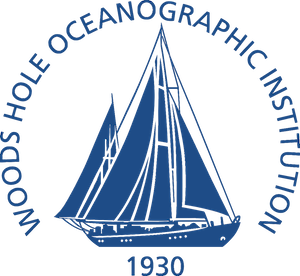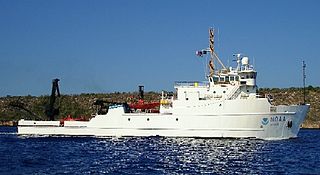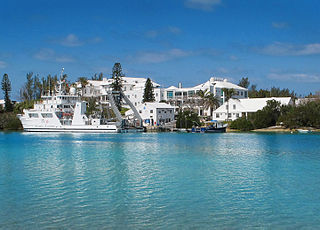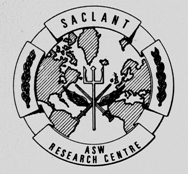
The Woods Hole Oceanographic Institution is a private, nonprofit research and higher education facility dedicated to the study of marine science and engineering.

A weather ship, or ocean station vessel, was a ship stationed in the ocean for surface and upper air meteorological observations for use in weather forecasting. They were primarily located in the north Atlantic and north Pacific oceans, reporting via radio. The vessels aided in search and rescue operations, supported transatlantic flights, acted as research platforms for oceanographers, monitored marine pollution, and aided weather forecasting by weather forecasters and in computerized atmospheric models. Research vessels remain heavily used in oceanography, including physical oceanography and the integration of meteorological and climatological data in Earth system science.

A research vessel is a ship or boat designed, modified, or equipped to carry out research at sea. Research vessels carry out a number of roles. Some of these roles can be combined into a single vessel but others require a dedicated vessel. Due to the demanding nature of the work, research vessels are often constructed around an icebreaker hull, allowing them to operate in polar waters.
The Integrated Ocean Drilling Program (IODP) was an international marine research program. The program used heavy drilling equipment mounted aboard ships to monitor and sample sub-seafloor environments. With this research, the IODP documented environmental change, Earth processes and effects, the biosphere, solid earth cycles, and geodynamics.
The Force d'action navale is the 12,000-man and about 100-ship strong backbone of the French Navy. As of 2018, it is commanded by Vice-Amiral d’Escadre Jean-Philippe Rolland.
The Lamont–Doherty Earth Observatory (LDEO) is the scientific research center of the Columbia Climate School, and a unit of The Earth Institute at Columbia University. It focuses on climate and earth sciences and is located on a 189-acre campus in Palisades, New York, 18 miles (29 km) north of Manhattan on the Hudson River.

NOAAS Rude was an American Rude-class hydrographic survey ship that was in commission in the National Oceanic and Atmospheric Administration (NOAA) from 1970 to 2008. Prior to its NOAA career, it was in commission in the United States Coast and Geodetic Survey from 1967 to 1970 as USC&GS Rude. It was named for Gilbert T. Rude, former Chief of the Division of Coastal Surveys of the Coast and Geodetic Survey.

RV Oceanus is a Regional Class research vessel owned by the National Science Foundation, based in Newport, Oregon, and maintained and operated by Oregon State University. The ship was originally delivered to the Woods Hole Oceanographic Institution (WHOI) for operation as a part of the University-National Oceanographic Laboratory System (UNOLS) fleet in November, 1975. Oceanus made her first operational cruise in April, 1976 and operated under WHOI for thirty-six years in the Atlantic with some operations in the Mediterranean and Caribbean. The ship was scheduled to be retired in November 2011 but instead was transferred to Oregon State University, College of Earth, Ocean, and Atmospheric Sciences, for operation, replacing her sister ship, R/V Wecoma.

R/V Thomas G. Thompson (AGOR-23) is a Global-class research vessel owned by the United States Office of Naval Research and operated under a bareboat charterparty agreement by the University of Washington as part of the University-National Oceanographic Laboratory System (UNOLS) fleet.

USNS Relentless (T-AGOS-18) was a Stalwart-class modified tactical auxiliary general ocean surveillance ship in service in the United States Navy from 1990 to 1993. Since 1998, she has been in commission in the National Oceanic and Atmospheric Administration (NOAA) fleet as the fisheries research ship NOAAS Gordon Gunter.

The NOAA Ship Nancy Foster is a National Oceanic and Atmospheric Administration research vessel.

NOAAS Thomas Jefferson is a National Oceanic and Atmospheric Administration (NOAA) hydrographic survey vessel in service since 2003. The ship was built for the United States Navy as USNS Littlehales (T-AGS-52) serving as one of two new coastal hydrographic survey vessels from 1992 until transfer to NOAA in 2003.

The Bermuda Institute of Ocean Sciences is an independent, non-profit marine science and education institute located in Ferry Reach, St. George's, Bermuda. The Institute, founded in 1903 as the Bermuda Biological Station, hosts a full-time faculty of oceanographers, biologists, and environmental scientists, graduate and undergraduate students, K-12 groups, and Road Scholar groups. BIOS's strategic mid-Atlantic Ocean location has at its doorstep a diverse marine environment, with close proximity to deep ocean as well as coral reef and near shore habitats.

Thomas Washington (T-AGOR-10) was a Robert D. Conrad-class oceanographic research ship delivered to the U.S. Navy in 1965. The ship was owned by the Navy but assigned to the Scripps Institute of Oceanography, University of California, La Jolla, California and operated as R/VThomas Washington from delivery to inactivation.

NOAAS Discoverer, originally USC&GS Discoverer, was an American Oceanographer-class oceanographic research vessel in service in the United States Coast and Geodetic Survey from 1966 to 1970 and in the National Oceanic and Atmospheric Administration (NOAA) from 1970 to 1996.

The SACLANT ASW Research Centre was the predecessor to the NATO Undersea Research Centre. It was known as The SACLANT ASW Research Centre from 1959 through 1986, and the SACLANT Undersea Research Centre from 1987 through 2003. The Centre was commonly referred to as SACLANTCEN.

RV Atlantic Explorer is a twin-screw ocean vessel. It is owned and operated by the Bermuda Institute of Ocean Sciences (BIOS) in coordination with and as a part of the University-National Oceanographic Laboratory System (UNOLS) fleet. Atlantic Explorer is in compliance with US Coast Guard, UNOLS and American Bureau of Shipping (ABS) regulations as an uninspected oceanographic research vessel and is supported by the National Science Foundation (NSF). Its homeport is St. George's, Bermuda.

NOAAS Pisces is an American fisheries and oceanographic research vessel in commission in the National Oceanic and Atmospheric Administration (NOAA) fleet since 2009.

The British Mid-Ocean Ridge Initiative was a multidisciplinary scientific investigation of the creation of the Earth’s crust in the deep oceans. It was funded by the UK’s Natural Environment Research Council (NERC) from 1993 to 1999.


















